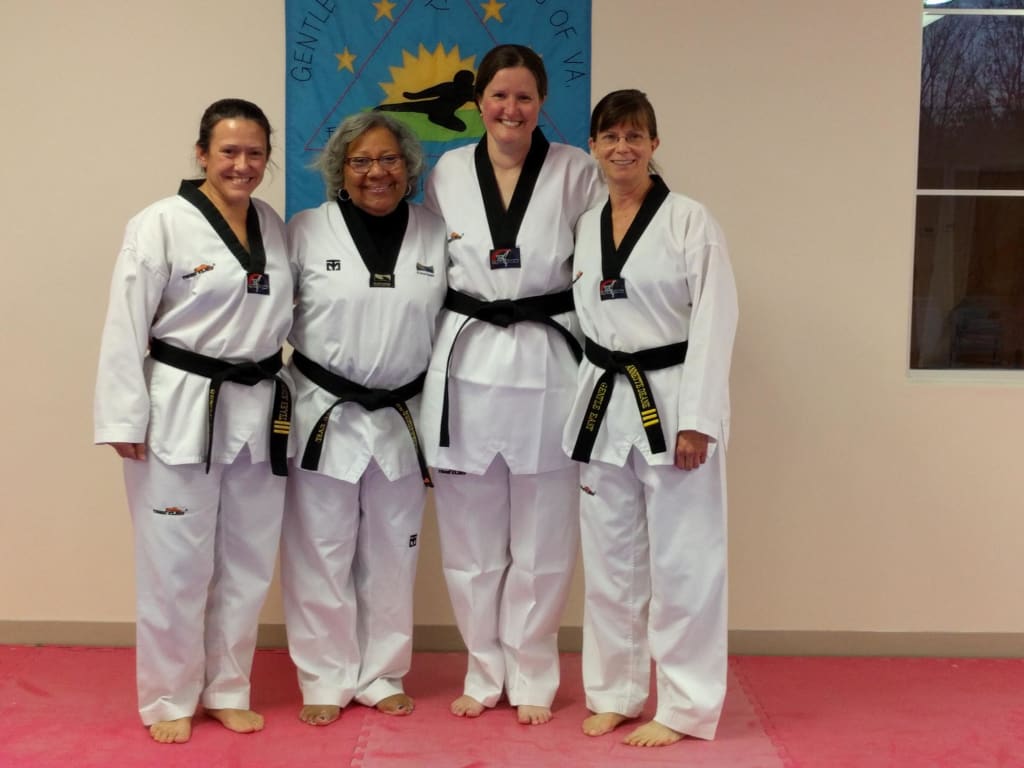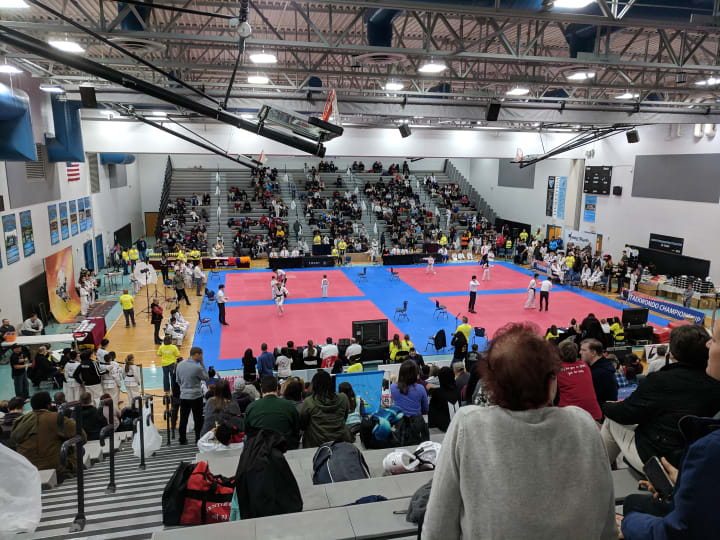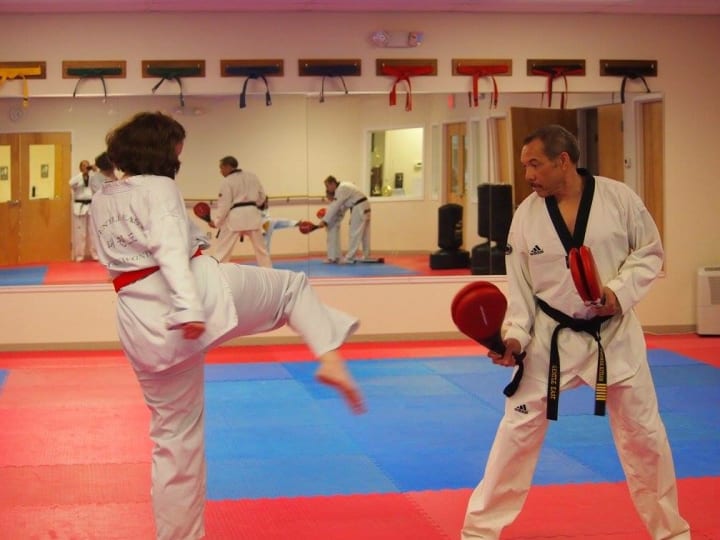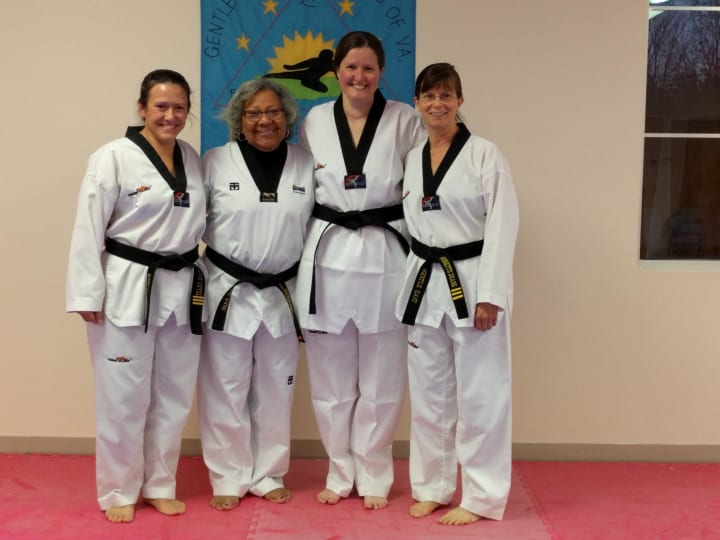How to Be a MMOMA
Or, How to Become a Force Multiplier

Take a look at this photo. From left to right, these women are Master Esther Kraft, Grand Master Barbara Robinson, the author (Kathryn Carson), and Master Annette Mau Deane of Gentle East Martial Arts of Virginia. Between us, we've lost count of the classes we've taught (together and separately), the competitions we've medaled in, and the boards and bones we've broken. Grand Master Robinson has no idea of the number of black belts she's conferred over the course of her long, amazing career. It numbers in the thousands. She conferred all three of the other belts in this photo, too.
In martial arts circles in the United States, it's widely believed that only one out of every ten thousand students earns a black belt. It's further believed that only one out of a hundred black belts goes on to earn additional degrees. When you factor that math against the hundreds of black belts her students have earned, plus the scores of second-, third-, and fourth-degrees, it amounts to a truly staggering number of lives this Grand Master has improved. And for nearly two decades, Masters Deane and Kraft have been right alongside her, helping her do it. (Side note: This photo is outdated. Of the four women pictured, I’m the only one whose belt hasn’t changed since the photo was taken.)
Yet taekwondo is merely one aspect of these women's lives. They've all maintained careers, raised families, faced serious health issues, and generally been another set of human stories amongst the billions of others on the planet. These three women are bad-ass in their own right, black belts or no.
Grand Master Robinson (or as we call her affectionately, “Ma’am”) grew up in a violent household. She was also a sickly child, unable to get out even though she wanted to. She spent many days of her childhood stuck at home from school, sick, with a front row seat to the punishment her father meted out randomly to her mother and siblings. One day, watching TV, listening to the awful quiet of the house as her dad slept it off again and her mom limped around and cried, that sickly little girl happened to see a Hong Kong martial arts movie. She watched the women flying around on the screen and was enthralled. In that moment she threw down a gauntlet to the universe: Lord, I want to do that. Make me well enough to do that, and I will train women and children never to be afraid.
It’s a testament to my master’s strength of spirit both that the universe listened, and that she made that luck happen whenever she could. Despite ill health, despite racism, despite her size and her gender both being profound strikes against her in a martial art that came to the United States via a generation of war-scarred men, she, as the saying goes, persisted. She persisted through an Ivy League education on scholarships, through raising three children, through a black belt in taekwondo, through founding her own school and rising through seven degrees of mastery. Despite coming from a family so poor they sometimes ate weeds from the roadsides, she did it. Through it all she kept her end of her bargain with God: in addition to teaching kids, she designed a class for mothers with small children called the MMOMAs (Mothers’ Morning of Martial Arts), which runs to this day.
The class is populated exclusively by women who are not only epic bad-asses at taekwondo, but also epic bad-asses in life. Among them have been an Army veteran with combat experience, four kids, and a horrific familial autoimmune disease. A SAHM whose children are so autistic one of them has been the subject of nighttime helicopter searches...twice. A medical professional with a background in both paleontology and archaeology, not to mention divorce, with an adult child so dysfunctional she personally dried him out six times but had to put him out in the literal rain when he failed the seventh. A special education teacher with rheumatoid arthritis, four kids (two of whom are special needs), and a husband so dramatically drunk he was once busted for DUI with the kids in the car, lost his license, and got the car impounded all at the same time. A Black female doctorate in education from that “school in Boston” who treats everyone’s kids like her own, but chose not to overcome her past to give birth to one.
These women deal with obstacles just as big as mine, and they look like pros doing it.
Taekwondo is like a hidden pulse, an invisible layer of knowledge and training and ability that hides in plain sight in these women’s daily lives; it's a skill as important and far-reaching as a skill can be, applying its benefits to every single facet of life, not just the parts we experience while wearing a dobok. It’s a skill that supports their lives, not the other way around. To them, taekwondo is useless unless it helps them be a better person.
I’d love to get into more detail about the masters and the things they’ve faced, but as Ma’am told me on my first day in class, “This class is often therapy with taekwondo thrown in.” The MMOMAs say things in class that even their own husbands and children don’t know. I’ve already revealed more than any of them would be comfortable with. So I must write a love letter to them in the way they would most appreciate: by sharing the things they’ve taught me, so that others might learn from it, too.
The thing the masters taught me isn't kicks or strikes, forms or breaking, how to "win" a fight or how to prevent being mugged—although I learned all of those things from them (and have used the mugging part in real life, too). They also taught me the "Five Tenets of Taekwondo," which are Courtesy, Integrity, Perseverance, Self-Control, and Indomitable Spirit. But there's one concept that underlies all those things.
They taught me how to achieve and maintain force multiplication.
Force multiplication is a military concept. A force multiplier is anything (an object, form of training, etc.) that allows its user to achieve more than they would be able to without it. A gun multiplies a person’s ability to kill, and so (in theory) does taekwondo.
But these masters didn’t teach me how to kill. They taught me how to live.
###
At first the martial arts seemed really daunting to me. On a mental level, I felt like I was being asked to dance while reciting the list of the Presidents of the United States backwards. It forced my mind and body to make connections in places I didn't know I needed, and it felt mentally draining even as it felt physically wonderful.
Emotionally, it was even tougher. I'd come to the martial arts desperate for a way to deal with my memories of living helpless on a college campus while a serial killer ran loose, murdering students. Every moment of my training for close combat felt like a spiritual leap into the unknown, because every moment provided an opportunity for unexpected physical input from others. So for a permanently anxious person like me—a person who'd spent years feeling unequal to the task of surviving life—it was a strong form of discipline just to show up and be seen and take hits.
But I was blessed with this group of courageous women teachers, who saw past my need to hide and who kept pulling me out of my shell. What began as the toughest spiritual discipline I'd ever faced became, over time, something I looked forward to...and the courage I developed there in the dojang became the courage I would come to need for all kinds of other challenges in my life.
My personal favorite learned skill (that both taught me force multiplication and helped me maintain it) turned out to be board-breaking.

At only my second test, barely past my yellow stripes, imagine my shock to hear Ma’am say, “Go get your board.” I’d assumed there was a training I’d missed. Nope. In our dojang, it’s learn-by-doing. Armed only with the basics explained to me by a helpful nine-year-old blue belt who found me standing helpless by the “woodpile,” I picked a board and cued up for the beginner's break. I tried to ignore the smell of pine boards and the certainty that what I was about to kick was a whole lot harder than my foot.
In my case, unfortunately, the beginner’s break resulted in a desultory "THWAP" sound as I bounced off the pine. It took me several tries, with my foot getting progressively more sore (and Ma’am getting progressively more annoyed with me), but I finally had an epiphany that can serve as Rule #1 of achieving force multiplication: The only way out is through.
As I regrouped from yet another failed kick, I finally listened to Master Kraft’s advice. "Aim back here, aim back here!" she said as she reached between my holders' arms to gesture about six inches behind the board I was trying to break.
She was right. The more I aimed at the board, the less likely I was to break it. I had to aim past the obstacle—through it. Otherwise I would stop where my vision (literally) ended. I had to pretend that the board wasn't there at all. In the oldest martial arts teachings, the teaching is even presented as if it's a Zen koan: "There is no board." So I did as she advised. Instead of focusing on the surface of the board, I focused on the elbows of my holders as if the board wasn't there at all.
The board broke easily. No pain, no splinters. It parted with a simple, and tremendously satisfying, CRACK! Two pieces of broken pine made me feel ten feet taller.
It took me months to get over my fear fully, and then several more months to yoke my power to my technique. But eventually one board became two, then three. There was literally nothing more satisfying in my taekwondo practice than testing myself against a stack of pine boards and hearing the wood break. Because in board-breaking practice, the strength of boards isn't additive. It's multiplicative. One board means you're novice-trained in taekwondo. Two means you're an adult or well-trained. Three means you're an adult black belt. Four means you now breathe the rarified air of the breaking specialist. Five or six means you're an artist. More than six boards—or if you branch out into the power-breaking staples like cinder blocks, bricks, rocks, or concrete pavers—might result in your becoming a worldwide sensation. Here's why those attitudes exist: A one-inch-thick pine board breaks at roughly the same amount of stress as a human toe or finger bone. Two boards is roughly equivalent to a bone in your hand or foot. Three is just shy of the breaking strength of a humerus, the tough upper bone in your arm. Four boards...that's just shy of a human femur.
Think about that. Taekwondo can confer the ability to break an attacker's thigh bone with a single kick...without breaking your own thigh bone.
Force multiplication indeed.
I've accomplished a four-board break, precisely once. I was only the second woman in the history of my master's dojang to do so. The other woman was, of course, Ma’am herself, back in the day. And if I hadn't trusted myself to her knowledge, if I hadn't committed myself to the practice and seen past my fear, I would never have known I was capable of it. I could have balked at the command to go get a board. I could have allowed my fear to get the better of me. I could have listened to the pain from my foot and decided that there was no technique that could avoid more pain for me. Instead, I committed to the path that others had blazed before me.
And I discovered...the only way out is through.
###
Rule #2 of Force Multiplication: If you find your discipline and keep at it, you will surprise yourself.
Before the black belt can be earned, it's traditional in our school to compete in a tournament. It should be at least a regional tournament—something large, and intimidating, and preferably it should involve multiple schools that aren't our own, so that the student can test her skill against other dojangs.

In my case, I didn't compete until the red belt. This upped the difficulty level tremendously, as by red belt most of the students that cross a dojang's doorstep have been weeded out. It's the belt at which I had to start teaching classes, minimum 100 hours before the black belt exam; it's the belt at which (in our school) I had already memorized and could teach thirteen forms from two separate taekwondo traditions. I virtually lived at the dojang five days a week, upwards of four hours each day, teaching classes and preparing for the black belt in my precious spare time, all of it on a volunteer basis. In fact, I paid for the privilege of being there.
But at this tournament, I wasn't an instructor. I was just one of an ocean of red belts, all of them younger, in better shape, and a whole lot faster.
There's a lot of shouting in taekwondo. Sparring and breaking make a lot of noise. The spectators cheering these events, as well as coaches and judges shouting orders and scores, are even louder. Put several thousand people under one roof, all of them doing taekwondo or screaming while they watch it, and frankly, I had to make a gut check just to get in the door. The sound value was staggering.
The massive convention center had been subdivided into arenas, each of them specially measured and matted to tournament sparring specifications—twenty of them, in fact, running concurrently. Dozens of people in doboks were sparring, breaking, and doing forms at the same time, while hundreds more competitors milled about between the mats. Each arena had its own panel of judges in suits and ties, plus assistants in head-to-toe black. Add in hundreds of screaming spectators everywhere, and it was an awful lot of input competing for my dwindling focus. It was an introvert's nightmare.
Then I saw the people I would be competing against. Every single one of the women in my age bracket were serious competitors, laser-focused on why they were there. I watched them perform gorgeous technical breaks—stuff that required them to break a board with one foot, then pause and hold their balance with that foot remaining in mid-air, as they jumped straight up with their standing foot and broke a second board.
I thought of the very simple combination break I'd planned—a three-board ax kick followed by a two-board front piercing kick—with despair. They were literally "basic" kicks, no different than the warm-ups we did every day. I didn't think they stacked up against such beautiful, technical skill. I wasn't even certain I could do a three-board ax; I'd never tried it before. It's nicknamed an "ax" kick because it replicates the motion of an ax chopping wood: Your heel (the "ax") swings nearly straight up in front of you (just barely to one side of where a chopping block would be), and then the ax swings straight down again dead center on the chopping block. It's intended for swinging your heel up past an attacker's shoulder and then bringing your heel straight down to break their collar bone. I could do that kick in my sleep. The only thing impressive about it was that I routinely cleared the height of my own head at the top of the arc. But did I generate enough power to take out three boards with it? I had no idea.
I could hear exactly what Master Deane had already said to me a dozen times: Too late now. Focus on what you’re doing. I parked my misgivings, found my holders and my boards, and when my name was called I bowed in and took my place before the panel of judges. I bowed to them again and announced my name and my chosen breaks.
And for the first time I thought I might have chosen well, because the entire panel of judges glanced at each other. A few of them even sat a little straighter in their seats, as if they were thinking, This might be good.
I positioned my holders, made sure they were solid and ready, and bowed to the judges again. Then I settled into what's called "free fight stance"—fists up, right foot back a step, knees bent—and breathed. One breath became two. Two became three. One of the judges flinched in his seat, as if his own muscles were urging me to leap into action.
Then something surprising happened.
I've read the entirety of the Japanese manga called Lone Wolf and Cub. It's a classic of the genre: a noble samurai, framed for an offense he didn't commit, is forced to wander the roads of feudal Japan with his infant son, righting wrongs and searching for vengeance. Before virtually every fight scene, there was a pause as the combatants sized each other up—and I knew, inevitably, who would win the fight. The person who would win was so focused that hazy, shimmering black lines would appear like a mirage over the heads of his opponent. It was so common a trope that it became annoying to me, especially after nearly thirty volumes of the stuff.
Imagine my shock as the third breath became a fourth, and all sound receded, and I forgot there was anything other than the boards I wanted to break...and black lines like a heat mirage shimmered in the air above the boards.
I found myself thinking only, Huh. That's a real thing? It's kinda cool.
And I swung my right foot up above my head and then down like a stone. I crushed three boards with my heel as if they were an empty tissue box. Then I pivoted smoothly through the 180 I'd planned and snapped the other two boards cleanly with the ball of my left foot. The only thought I had was, I could've done four and three, easy.
As I picked up the splinters I'd made and bowed my way off the mat, I watched the competitors I'd feared begin to reassess their own power...to visibly think, with wide-eyed looks on their faces, Maybe I can do that, too. They mobbed me after I got off the mat, congratulating me and telling me how excited they were to try those breaks when they got home. I knew I'd just turned one tournament break into a small army of women completing huge tournament-breaks for years to come, because they would take that story home with them to their own students.
I didn't just win a gold medal that day. I surprised myself.
###
Rule #3: Keep at it some more, and you'll inspire others.
As proud as I was of that particular break, it was a success. It's easy to be proud of my successes. The failures or qualified successes, though...that's a little tougher.

My four-board kick was a qualified success. The reason? It's tough to break boards. It's even tougher to break more boards. It's toughest of all to break a lot of boards when you have human holders. Human hands can span only so many inches; human shoulders are made of muscle and therefore give rather than hold firm; and only so many human beings can fit in a small area behind a board and still exert any real force against it. I freely admit that I find holding boards far harder than breaking them. My shoulders give too much. It's hard for me to get enough of my fingers and thumbs out of the way so that an errant foot only mushes them rather than breaking them. It's difficult for me to trust that the breaker won't break me, and I have to close my eyes and look away, which seriously impedes my ability to be a good holder and lean into the impact. And since I'm a woman, my hands physically don't span as far as a man's can, which precludes me from safely holding anything more than a three-inch stack of boards.
So, when it came time for me to attempt a four-board break at our dojang, I knew the holding situation was going to be tough. I ended up with a pyramid of people behind that ten-inch-square surface. Two men holding the stack. Two more men holding the holders' wrists. Three more people standing behind those four and leaned in, pushing against their shoulders. And one absolute beast of a parent—a Spartan and Tough Mudder racer in her spare time—pressing into the backs of the shoulder guys.
My first attempt hit off-center and I mushed one of my holder's fingers. I was staggering-tired, running on only two hours of sleep that day. It was a miracle I competed at all. But I was determined, and he was fine—an experienced holder knows that a flat finger-mush does no lasting damage—and we cued up again. This time, the holders leaned in hard. I'd driven them all back a solid step, even with that off-center hit.
Attempt number two resulted in no break. The holders stepped back up to where they'd been, got settled, and leaned in harder.
Attempt number three resulted in a tiny "pop!" sound. My holders checked the boards, but none of them were compromised. I despaired that this break was going to happen. But everyone in the dojang around me was either shouting as they rooted for me, or were so tense they made no sound at all. More than one person was literally chewing their nails. So I parked my despair and promised that I'd let fly just one more time and see what happened.
My holders settled into stance and leaned so far forward that the Spartan runner in the back was nearly sideways.
When the stack broke, the dojang erupted into cheers. It was announced that I was only the second woman ever to achieve this break in our dojang. Ma’am nodded at me sagely, as if to say, See? I told you you could do it. One of our instructors cracked a joke at a student who was slated to spar me later, saying, "You know you're about to spar someone who has a four-board back kick, right?" Everyone who wasn't the student cracked up laughing. The student turned a little green. But all the female students—including the green one—walked around for the rest of that afternoon with their heads held an inch higher.
I was just grateful the break was over. But it felt...unfinished. Yes, I'd broken. Yes, the stack was good. But that "pop!" bugged me. And the fact that it took me four tries to break bugged me even more. It would have been considered a failure according to regional tournament rules. Yes, I had been exhausted. And yes, it was an in-house tournament, so my masters could let a fourth attempt slide. But had my technique been good enough, my speed fast enough, I wouldn't have needed four tries. After all, I'd once seen a teen-aged boy break a five-board stack so fast that his own father, prepped and ready to film everything, immediately wailed, "I didn't see it! It happened so fast!"
As it was, I didn't take gold for my break, but a silver. The gold went to a young man who absolutely destroyed two sets of three boards with nothing more than knife hand strikes. They were gorgeous breaks, and well-deserving of first place. (My break was nonetheless celebrated all around the building, and still gets mentioned in older students' lists of "bad-ass breaks they've seen.")
But that's not why I'm proud of it.
A few months later, we'd managed to cajole one of our students' moms into joining us in the MMOMAs class. She was a hugely intelligent student with a wicked sense of humor. We were sad indeed that she would be leaving us as soon as the school year started and she resumed her work as a teacher. We were also secretly sad to see her shortchange her foray into the martial arts, because the woman was saddled with an abusive husband. Our opinions about her situation had to remain private. But we taught her as much as we possibly could while we had the time together, and could only hope that some day those skills and self-confidence would lead her to better choices...and safety.
She told us that her youngest child, a four-year-old girl who was playing in the next room, would be sad to leave...because she liked to watch me, "the lady who defeated eight men."
I stopped dead in the middle of my form. "Wait, what? 'Defeated eight men?'"
"When you did that big break a few months ago. She saw all those people holding your boards move backward every time you hit. So to her, that means that you defeated them."
Just thinking about that little girl makes me tear up.
That little girl will grow up knowing, in her gut, that there's nothing she can't do because she's a girl. She'll grow up knowing that a girl like her can "defeat eight men." The moment of my life that I had dismissed as a failure, she took to heart as an epic example of bad-assery. In her little heart, there will always be two examples of women: those who are defeated by men, and those who defeat men.
I am proud and humbled to be the example that might, someday, lead her out of the cycle of abuse. I can only hope that her mom will have someday modeled that for her, too.
An entire dojang of females walked taller the day I broke, and a little girl saw a way out of her circumstances. They will all hopefully go on to make better choices, and have better effects on each other and on their world. Add in all the women inspired by my Lone Wolf and Cub break, and the students they will someday train. Add in all the female masters at my school, the amazing example of my Grand Master and the decades of their combined service... It begins to look like we're a stone dropped in a pond of women, and the ripples will go on for a long time, to inspire generations we will never see.
Force multiplication indeed.
###
Remember this black belt picture? This was the day I finally took my black belt exam in 2016. It was the first wearing of my brand-new, black-bordered dobok and my brand-new black belt.

I was also just a couple months past my diagnosis of a rare cancer called ocular melanoma type 2 (OM2). I was barely a month past two surgeries and a week of implanted radiation. I spent a lot of that test exhausted, shaking like a leaf while I rested in a chair, when I really wanted to be up and doing forms and breaking boards and sparring instead. I hated feeling like I was letting everybody down. I despaired that I would make it through enough of the test to pass.
But even as I fell into that chair to rest again, even as I lamented to a friend how poorly I must be doing and how terrible I must look doing it, she leaned over and whispered into my ear, "I think it's the baddest-ass thing I've ever seen."
And I made it. I passed that test, despite not being able to spar or break, despite feeling like my body was strung together with nothing more than chewing gum and bungee cords. I discovered for myself that day...
The only way out is through.
If I keep at it, I'll surprise myself.
And if I keep at it long enough, I'll inspire others.
###
Now it's 2021. I'm still "dancing with NED" (that's cancer-patient-speak for "no evidence of disease"). I made it through a clinical trial. I'm defying my one-in-four odds just by breathing. But even as the blizzard of OM2 issues has begun to subside, multiple sclerosis (MS) is taking its place.
Through it all, I've continued being a wife and mother and sister and daughter. I've kept up with my taekwondo. I Zoom my classes. I do forms in my head when I'm in the MRI. If I'm alone in the waiting area of whatever hospital I'm in, I practice forms physically instead. It's a tremendous comfort to know exactly what move comes next in a form, because after the lessons of OM2, MS, and two years and counting of COVID in a healthcare family, I have no idea what's coming next in real life.
Eventually I plan to return to the dojang and take up assisting with the forms class again. I'll keep achieving in different ways, even as my physical abilities change with age and infirmity. I can no longer spar or break, but I still use the fighting spirit that taekwondo brought out. I use every bit of the person I didn't know I had in me to face every new day. Every day that I'm breathing, I accomplish so much more than I ever knew I could.
In short, taekwondo taught me force multiplication—how to do more than I ever thought possible. At more than a decade into my taekwondo experience, I'm finally learning that force multiplication is about so much more than breaking boards. It’s about breaking stereotypes, breaking fear, and breaking through the barriers that life puts in my way.
My masters taught me how to do all that...and live.

About the Creator
Kathryn Carson
I have MS, Hashimoto's, and a black belt in taekwondo. I'm also an ocular melanoma survivor. This explains why my writing might be kind of obsessed with apocalypse--societal, religious, and personal.






Comments
There are no comments for this story
Be the first to respond and start the conversation.